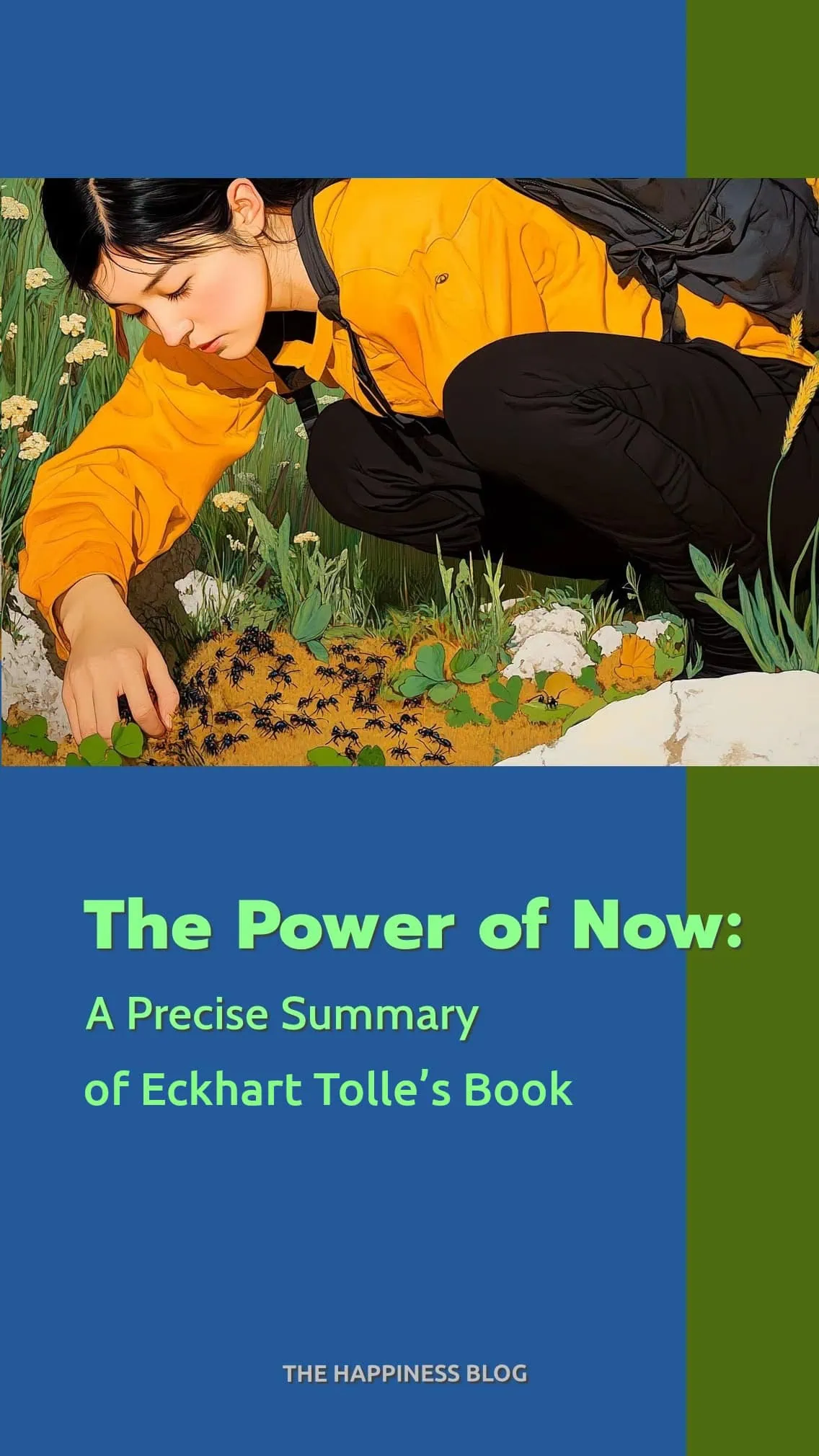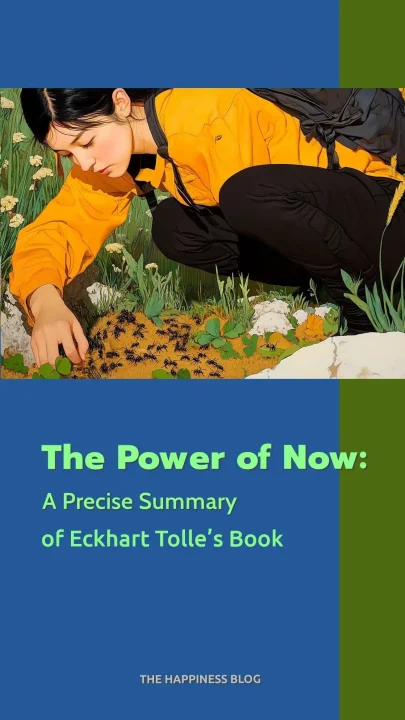Today's Tuesday • 12 mins read
After reading this precise chapter-wise summary of Eckhart Tolle’s international bestseller The Power of Now, you will:
- Learn how to detach yourself from your “ego” — the part of your mind that wants to control other people and outside events.
- How to settle your mind into peace, away from mental unease, regrets of the past, and anxieties of the future.
- And how to cultivate a present-moment awareness to live an active life without being judgmental.
Before he became a globally loved and revered spiritual guide, Eckhart Tolle suffered from depression for most of his life. The Power of Now tells the story of his spiritual journey to inner transformation, and how anyone can learn to do the same.
Quick Summary:
In The Power of Now, Eckhart Tolle reveals how to achieve inner tranquility and spiritual transformation by focusing on the present moment. He explains how our habitual thought patterns cause most of our life’s sufferings. And offers practical tools, like observing the “pain-body” and mindfulness meditation, to help us overcome them.
“To be in the body is to be in the present moment, the only place where you can experience true inner peace and freedom from suffering.” — Eckhart Tolle
Chapter-Wise Summary of The Power of Now
A mindful person operates in the present moment without worrying or overthinking. This summary of The Power of Now will help you to become a mindful person.

Chapter 1: You Are Not Your Mind
Eckhart Tolle opens by challenging us to recognize that we are not defined by our thoughts. Psychology agrees with him — your thoughts don’t define who you are.
Our over-identification with the mind—the “self” generated by our thoughts—disconnects us from our true essence. It traps us in cycles of worry about the past and future, making us suffer emotionally.
To break free, Tolle introduces the concept of “watching the thinker” — observing your thoughts and emotions without judgment. Here’s an example of “Watching the Thinker”:
Thought: “I always mess things up. I’m such a failure.”
Watching the Thinker: “I am having the thought that…”
- Reframe: “I am having the thought that I always mess things up and that I’m a failure.”
- Observe: That prefix creates a distance between your thought and yourself (dissociation), telling you that the thought is just a mental event occurring.
- Acknowledge: Intensify your dissociation by saying, “This is a thought I am experiencing right now. It doesn’t define me; it’s just passing through.”
- Return to presence: Focus on your breath, surroundings, or inner body sensations to ground yourself in the moment.
Doing this when having self-critical thoughts helps us detach from thoughts and negativity attached to them, letting us a sense of inner calm.
Just remember that what you think is not who you really are.
“You are not your mind. You are the awareness behind the thoughts, the silence behind the noise, the stillness beneath the mental turbulence.”

Chapter 2: Consciousness: The Way Out of Pain
In this chapter, Tolle explains that much of our emotional pain stems from the “baggage” of past and future worries.
He tells us that freedom from this pain lies in cultivating present-moment awareness, as the present is the only reality we truly have.
Tolle acknowledges that the present moment may seem unpleasant or frightening at times. But also adds that these judgments arise from the mind’s tendency to label experiences.
Once we learn to stay fully conscious in the “now,” we can detach from these labels and release the negative thoughts and emotions that keep us trapped in mental loops.
As we embrace the present, we naturally begin to let go of the emotional burdens that fuel overthinking and unhappiness, opening the way to inner peace.
“The pain that you create now is always some form of non-acceptance, some form of unconscious resistance to what is.”
Chapter 3: Moving Deeply Into The Now
Tolle explains that much of human fear and dissatisfaction stems from the ego, which feels perpetually threatened and incomplete.
He argues that our problems are illusions created by the mind and cannot be resolved at the same mental level where they originate.
A key insight in this chapter is to let go of the concept of linear time.
Tolle emphasizes that nothing truly exists outside the present moment.
- The past is a memory reactivated in the now, and
- The future is a projection imagined in the now.
Freedom won’t come from waiting for a future salvation. An embracing of now can help us transcend the illusions of time and tackle life’s challenges with clarity and peace.
Tolle gives us these beautiful words for becoming more fully present in the now:
Be where you are. Look around. Just look, don’t interpret. See the light, shapes, colors, textures. Be aware of the silent presence of each thing. Be aware of the space that allows everything to be. Listen to the sounds; don’t judge them. Listen to the silence underneath the sounds. Touch something — anything — and feel and acknowledge its Being. Observe the rhythm of your breathing; feel the air flowing in and out, feel the life energy inside your body. Allow everything to be, within and without. Allow the “isness” of all things. Move deeply into the Now.
Tolle says that many of our problems are caused by our negative interpretations of circumstances, based on our beliefs.
Circumstances –> Beliefs –> Interpretations –> Suffering
To find greater peace, see things across your illusions of your “interpretations”.
“End the delusion of time. Time and mind are inseparable. Remove time from the mind and it stops — unless you choose to use it.”
Chapter 4: Mind Strategies For Avoiding The Now
The dissatisfied mind constantly seeks to escape the present moment, believing fulfillment lies in the future.
However, this strategy only perpetuates dissatisfaction, as the mind will never be satisfied, even when the future arrives.
He emphasizes the importance of balancing life’s outer purpose—goals and achievements—with an inner purpose, which involves staying rooted in the present moment. While the outer journey unfolds in the dimensions of time and space, the inner journey deepens our connection to the timeless Now.
Tolle reminds us that the present is the only reality. By accessing the power of Now—awareness freed from thought—we can address past wounds and challenges in the present and dissolve their emotional hold, allowing us to live with greater peace and purpose.
If you are dissatisfied with what you have got, or even frustrated or angry about your present lack, … deep down you will continue to feel unfulfilled. You may have many exciting experiences, but they will … always leave you with an empty feeling and the need for further physical or psychological gratification.
“What is essential is your conscious presence. That dissolves the past. That is the transformative agent. So don’t seek to understand the past, but be as present as you can.”
Chapter 5: The State Of Presence
In this chapter, Tolle explores the transformative power of presence, a state of heightened awareness that allows us to fully experience the present moment without being dominated by thoughts or emotions.
Presence dissolves the ego, freeing us from fear and stress, and connects us to our authentic self.
Tolle explains that being present sharpens our focus and allows us to engage with life more deeply, appreciating the beauty of nature and feeling a profound connection to the universe. This state reveals the interconnectedness of all things, enabling us to see life as an expression of divine essence.
By embracing presence, we can transcend feelings of disconnection and discover greater peace, clarity, and joy in every aspect of life.
“All you really need to do is accept this moment fully. You are then at ease in the here and now and at ease with yourself.”
Chapter 6: The Inner Body
Tolle argues most of us are disconnected from our bodies, which keeps us disconnected from the present moment.
We can learn to connect with the inner body and deepen our sense of presence.
Tolle reveals how to connect with your inner self:
Please try it now. You may find it helpful to close your eyes for this practice. Later on, when “being in the body” has become natural and easy, this will no longer be necessary.
Direct your attention into the body. Feel it from within. Is it alive? Is there life in your hands, arms, legs, and feet — in your abdomen, your chest?
Can you feel the subtle energy field that pervades the entire body and gives vibrant life to every organ and every cell? Can you feel it simultaneously in all parts of the body as a single field of energy?
Keep focusing on the feeling of your inner body for a few moments. Do not start to think about it. Feel it.
The more attention you give it, the clearer and stronger this feeling will become. It will feel as if every cell is becoming more alive, and if you have a strong visual sense, you may get an image of your body becoming luminous.
When we tune in to the inner body, we can tap into a deeper source of creativity and inspiration and find a profound sense of well-being and being grounded.
Chapter 7: Portals Into The Unmanifested
In this chapter, Tolle introduces the concept of the unmanifested—a realm beyond form and thought that serves as the source of creativity, inspiration, and spiritual renewal.
He explains that we can access this hidden dimension of consciousness through various “portals,” such as heightened sense perceptions, awareness of the inner body, and moments when thinking ceases.
By engaging with these portals, we transcend the limitations of our thoughts and emotions, connecting with a deeper intelligence that offers clarity, intuition, and wisdom.
So use your inner body as a portal through which you enter the Unmanifested, and keep that portal open so that you stay connected with the Source at all times. It makes no difference, as far as the inner body is concerned, whether your outer physical body is old or young, frail or strong. The inner body is timeless.
Tolle suggests that accessing the unmanifested not only enriches our inner lives but also allows us to unleash our full potential and positively impact the world around us.
To foster this, he encourages practices such as
- spending mindful time in nature,
- nurturing loving relationships, and
- deepening our awareness of the body’s energy field.
These activities help quiet the mind and anchor us in the present moment, opening the door to this transformative state of being.
“When you become aware of silence, immediately there is that state of inner still alertness. You are present. You have stepped out of thousands of years of collective human conditioning.”
Chapter 8: Enlightened Relationships
In this chapter, Tolle explains how cultivating presence and awareness is the foundation for enlightened relationships.
By being fully present in our interactions, we transcend ego-driven patterns of thought and behavior that often cause conflict and disconnection. This allows us to communicate with authenticity and compassion, fostering deeper and more meaningful connections.
Tolle emphasizes that relationships can serve as mirrors, reflecting our own patterns, triggers, and unconscious behaviors. By observing our reactions and those of others, we gain valuable insights into ourselves, deepening self-awareness and fostering empathy.
He also highlights the interconnectedness of all beings, reminding us that the apparent separateness of others is an illusion. Recognizing this shared consciousness enables us to build relationships grounded in love, respect, and understanding.
Ultimately, Tolle views relationships as opportunities for mutual spiritual growth, offering a path to co-awakening when both individuals embrace the present moment together.
“When you interact with another, an alert and loving presence emerges from you both. This presence is essentially who you are.”
FAQs
Are women closer to enlightenment?
He feels women are generally more in tune with their bodies and emotions than men, which makes them more receptive to the spiritual nature of their presence.
He also thinks women’s role in childbirth and nurturing life increases their spiritual awareness. However, true enlightenment transcends gender identity labels.
What surprises the readers in the book The Power of Now?
Tolle argues that we tend to identify with our thoughts, which leads to negative emotions and mental suffering. But, by recognizing that our thoughts are separate from ourselves, we can break free from this cycle and achieve inner peace.
This can be a major paradigm shift for readers and can lead to a transformative experience.
What is the message of Eckhart Tolle’s The Power of Now?
Final Words
Take-home messages:
- Peace is in the present moment: A mind filled with regrets of the past or anxiety about the future can never settle into peace. The present moment is the only reality we truly have. And once we train our mind to be in the now, peace comes to us.
- Disidentify from the mind: Much of our suffering stems from identifying too strongly with what we think. But the truth is, we are not our thoughts. Observing the mental chatter without judging or attaching to it, we can break free from its control and feel deep satisfaction.
- Embrace the pain-body: Emotional pain is stored in what Tolle calls the “pain-body,” a form of accumulated past trauma. Awareness of this pain-body without resistance helps dissolve it, enabling personal growth and spiritual awakening.
All you really need to do is accept this moment fully. You are then at ease in the here and now and at ease with yourself.
Mindfulness can help us realize the ultimate purpose of our existence and expand our relationships with ourselves.
√ Also Read: Summary of “The Wisdom of Psychopaths”
√ Please spread the word if you found this helpful.
• Our Story!
